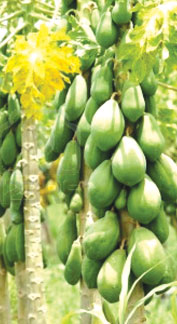Shot-in-the-arm for papaya cultivation
By Lalin Fernandopulle
Papaya farmers in Jaffna are a happy lot due to the bountiful harvest
they reap each week. The hybrid red lady yields a large harvest and
brings in good returns to farmers who cultivate the crop in vast swathes
of land.
A regular market and high prices are a shot-in-the-arm for papaya
cultivators in the North who earn a satisfactory income from the crop.
The farm gate price of a kilogram of papaw is around Rs. 40.
 The low maintenance cost encourages papaw cultivation. Farmers say
that they could recover the initial investment on papaw cultivation with
the income they earn from each tree. The low maintenance cost encourages papaw cultivation. Farmers say
that they could recover the initial investment on papaw cultivation with
the income they earn from each tree.
M. Senadirajaj, a large papaw grower in Allaveddy harvests around 300
kgs a week from his one-acre cultivation which consists of around 4,000
trees.
He is an intermediary crop grower, earning an income of Rs. 170,000 a
month. Agriculture has been the primary source of income for centuries
to the people in the North. The rich fertile soil known as Calcic red
yellow latozols, yields a bountiful harvest.
Paddy and a range of fruits and vegetables grow in abundance in the
North. While chillies, red onions, cabbage, potatoes, radish and ground
nuts are some of the widely-grown field crops, the Jaffna mangoes and
grapes are popular in the country. Farmers of Jaffna use well water for
irrigation.
A papaw tree begins to bear fruit at a height of around 60-80
centimetres and a bears around 30 fruits at a time. Fruits are short and
oblong on female trees and rather long-shaped on bisexual trees,
weighing about 1.5-2 kg.
Papaya botanically known as Carica papaya bears fruits throughout the
year. It requires less area per plant, is easy to cultivate and provides
a high income per hectare. The seedlings are raised in nursery-beds, in
pots or polythene bags.
Senadirajah said that the quantity that is wasted has dropped due to
the stable market that has been created in the North. He said there is
less exploitation by middlemen.
P. Sukolingam, a papaya grower in Jaffna said that he earns a
satisfactory income from papaya cultivation but still bears a
substantial cost on irrigation. He said that he spends around Rs. 50,000
to fertilise around 200 trees. The price of a kilogram of papaya rises
during the off-season.
A tree yields within six months of planting. Papaya is cultivated in
Sri Lanka primarily as a home garden crop. However, there is a limited
extent under commercial cultivation and this is steadily increasing.
A research officer of the Department of Agriculture said that if
farmers grade their trees as malformed, medium and large fruit bearing
trees they could get better prices.
Papaya is rich in nutrition. All the nutrients promote the health of
the cardiovascular system and provide a shield against a number of
chronic diseases. Papaya also contains large units of papain, a
digestive enzyme. This enzyme is often extracted from the fruit to make
anti-inflammatory and analgesic medicines.
Farmers said that the demand for fruits has increased in the North
due to the development in the hotel sector.
Fruit and vegetable farmers have been assured of a stable market and
a better price for their produce by private sector organisations who
have set up collection centres to support agribusiness in the North and
help eliminate the middlemen.
The collection centre of Cargills Ceylon PLC offers a better price
for the produce and helps minimise post harvest waste. The Centre
provides plastic crates to farmers to transport their produce.
|



